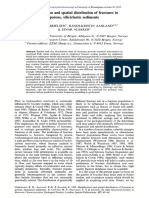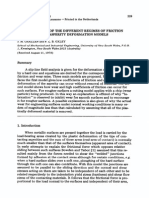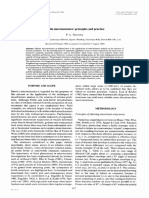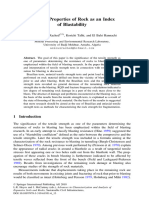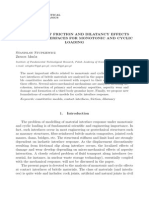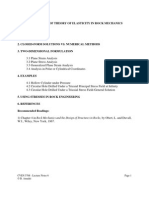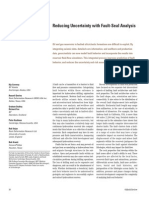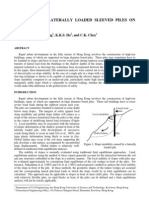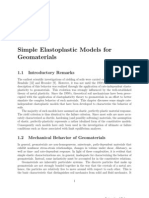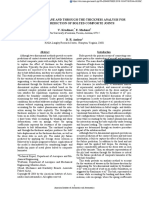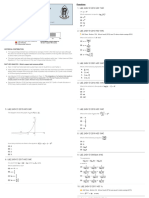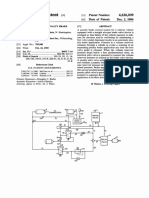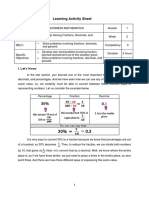Zero Extension-1
Zero Extension-1
Uploaded by
Dhara Adhnandya KumaraCopyright:
Available Formats
Zero Extension-1
Zero Extension-1
Uploaded by
Dhara Adhnandya KumaraOriginal Title
Copyright
Available Formats
Share this document
Did you find this document useful?
Is this content inappropriate?
Copyright:
Available Formats
Zero Extension-1
Zero Extension-1
Uploaded by
Dhara Adhnandya KumaraCopyright:
Available Formats
Journal of Structural Geology 21 (1999) 939948
www.elsevier.nl/locate/jstrugeo
The future of failure: stress or strain?
Juan Watterson
Fault Analysis Group, Liverpool University Marine Laboratory, Port Erin, Isle of Man, IM9 6AJ, British Isles
Received 6 April 1998; accepted 5 November 1998
Abstract
Strains in rocks can be observed but ancient stresses can only be inferred. We should re-examine the potential of strain
geometry as the key to understanding and interpreting common shear structures ranging from faults to plastic shear zones. The
concept of failure along zero extension directions can be applied to natural structures in rocks and is predicated on strain
compatibility between dierently strained volumes. Zero extension directions are considered for two strain congurations, plane
strain (k 1) and uniaxial shortening (k 0). The crucial dierence between shear fractures, or faults, and plastic yield zones is
that the former are preceded by dilatation while the latter are isovolumetric. Volume changes during deformation aect the
orientations of zero extension directions and hence of the resulting structures. With isovolumetric strain, yield occurs on planes
at 458 to the principal shortening direction in plane strain and at 54.78 to this axis in uniaxial shortening. Uniaxial shortening
experiments on rock samples allow estimation of the relative volumetric strains when yield zones initiate. When this volumetric
strain is used to estimate the orientation of shear fractures in plane strain, ca 708 dips are predicted for normal faults at high
crustal levels, decreasing downwards to 458. # 1999 Elsevier Science Ltd. All rights reserved.
1. Introduction
Because we deal with relatively large, and therefore
observable, strains, geologists generally have a much
better understanding and appreciation of strains and
displacements than we have of stresses and forces,
which in any case can only be speculative for ancient
events. Vindication of this cultural predisposition is
provided by Burland (1965), (quoted in Roscoe, 1970),
who pointed out that while ``stress is a philosophical
conceptdeformation is a physical reality''. Engineers
often express problems in terms of stress partly
because most engineering materials undergo very little
strain before disruptive failure and partly because
stresses and forces acting on engineered systems can be
either calculated or measured, albeit indirectly. But engineering practice provides no basis for geologists
either to view stress as a `cause' of deformation
(Edelman, 1989) or for a conjectural stress conguration to be the structural geologist's apotheosis.
In spite of geologists' familiarity with strain, their
E-mail address: fault@fag.esc.liv.ac.uk (J. Watterson)
analyses of faulting and of fault systems are very often
expressed in terms of stress even though macroscopically ductile shear zones, which form a continuum
with faults, are invariably described in terms of strain.
This dierence in approach determines not only how
things are described but, more fundamentally, what
questions are asked. The questions asked about faults
have traditionally concerned their orientations relative
to principal stress axes, with responses invoking
MohrCoulomb or similar failure criteria based on
consideration of stress. The questions asked about
shear zones have concerned geometry, strain and displacement. While no single approach is likely to be the
one true path to enlightenment, a unied model for
the various types of geological shear structures would
be helpful. This article attempts to introduce a very
preliminary version of a unied strain model for geological heterogeneous yield structures, and is limited to
consideration of simple shear structures although the
method is also applicable to pure shear structures, e.g.
boudins. The immediate question addressed concerns
the orientations of simple shear structures, but if the
approach is valid it also has potential for development
0191-8141/99/$ - see front matter # 1999 Elsevier Science Ltd. All rights reserved.
PII: S 0 1 9 1 - 8 1 4 1 ( 9 9 ) 0 0 0 1 2 - 7
940
J. Watterson / Journal of Structural Geology 21 (1999) 939948
of a model in which yield structures are treated as
minimum energy responses to a bulk deformation. The
concepts used are well established in those disparate
parts of the spectrum of engineering concerned with
the properties and behaviours of materials varying
from polymers, soils and metals to granular aggregates, and the literature on these topics is drawn on
freely. As bets a unied approach, the terms failure
and yield are treated as synonyms. `Plastic' is used in
its general sense of deformation by intracrystalline or
diusive ow (Rutter, 1986), encompassing the mechanisms associated with `macroscopically ductile' shear
zones.
My interest in the topic arose from eld work on
conjugate sets of syn-kinematic mac dyke swarms
and on related strike-slip shear zones (Watterson,
1978). For both, conjugate angles containing the shortening direction are >908, giving rise to the obvious
questionwhy obtuse angles?
2. Constant volume strain
2.1. Orientations of shear zones and faults
A critical dierence between plastic shear zones on
the one hand and `brittle' faults on the other, is that
the conjugate angle containing the principal shortening
axis of the bulk strain is r908 in the case of shear
zones and is <908 for faults (Ramsay and Huber,
1987, p. 612), typically 40608 for normal faults
(Anderson, 1951). Another crucial dierence between
plastic yield and brittle failure in rocks is that the former is generally, although not necessarily, a constant
volume process whereas the latter is always associated
with a dilatation, or positive volume strain (Rutter,
1986). This dierence suggests that the controls on
orientations of plastic shear zones might be more
simply dened than those of faults, which represent a
non-isovolumetric variation of the less complex isovolumetric case. Following this line of argument we rst
examine the controls on orientations of plastic shear
zones. It is argued that localised shear failure takes
place parallel to zero extension directions in the
matrix. Discussion is limited to the two bulk strain, or
loading, congurations represented by plane strain and
by uniaxial shortening, with discussion of the isovolumetric case followed by that of the non-isovolumetric
case.
2.2. Plastic shear zones
The simplest case to consider is that of localised
simple shear zones accommodating a bulk pure shear
plane strain, with no volume strain. The bulk deformation is assumed to be accommodated exclusively on
numerous shear structures each of which is small relative to the strained volume, so neither the boundaries
nor the shape of the volume play a signicant role in
determining either the locations, orientations or geometries of the localised strains. The bulk strain is the
sum of the high local strains, shear zones, and the
lower matrix strains. A major attraction of the simple
shear model for rock deformation on both small
(Ramsay and Graham, 1970) and large scales (Escher
et al., 1975) is that a high strain shear zone remains
compatible with its matrix without a discontinuity
developing between the two. This compatibility exists
because a shear zone boundary is parallel to the plane
of shear, within which every direction is a line of no
nite longitudinal strain, and is also a line of no innitesimal longitudinal strain. Ideally, therefore, there is
no `mist', or strain incompatibility, between either (i)
the deformed shear zone and its, supposedly
unstrained, matrix, or (ii) regions of dierent shear
strain magnitudes within the shear zone, so long as the
shear strain contours are parallel to the shear zone
boundary, or shear plane. Any strain gradient within a
shear zone can be accommodated compatibly so long
as the gradient is normal to the shear plane. Strictly
speaking, strain compatibility requires only that longitudinal strains on either side of a shear zone boundary
are the same rather than zero but, in practice, nonzero identical strains would represent a very special
case (Treagus, 1983) not likely to occur with a simple
shear zone. Complications do arise nevertheless,
because strain gradients parallel to the shear plane
must occur in order to accommodate the lateral displacement gradients which are universally present along
both shear zones and faults. These complications are
not considered further as they do not aect the conclusions. What follows does not conict with the shear
zone model of Ramsay and Graham (1970) but simply
extends it by imposing more restrictive conditions.
The now traditional shear zone model predicts nothing explicitly about the orientation of a geological
shear zone because, as its matrix is considered as
undergoing no strain, all shear zone orientations are
equally compatible with their matrix; although if strain
is accommodated entirely by shear zones their orientations must be such as to accommodate the imposed
bulk strain. The freedom of orientation arises from a
simplication in the model, which is that the matrix is
considered as being unstrained and therefore not contributing to the bulk strain. In practice, there will
always be a penetrative strain of the matrix, either
elastic or both elastic and permanent. As is shown
below, if the local and matrix strains are compatible,
the principal strain axes of the bulk strain will be congruent with those of the matrix strain.
The potential strain incompatibility between a shear
zone and its matrix is, therefore, the key factor deter-
J. Watterson / Journal of Structural Geology 21 (1999) 939948
mining the most likely orientation of a shear zone.
Although strain compatibility is expressed in terms of
geometry, the geometry is an implicit proxy for minimum energy as, in principle, all geometries are possible. As compatible strains must be maintained
throughout, ideally the problem should be discussed in
terms of instantaneous strain rates, or relative strain
rates, rather than strains. This is because the strains of
concern are those which are taking place at the time
when the location and orientation of a shear zone
becomes established, which is well before yield occurs.
The situation at this instant of time is more precisely
represented by strain rates, or relative strain rates,
than by accumulated strains. For present purposes this
renement is not necessary so long as it is remembered
that all strains referred to are small incremental
strains, either elastic or permanent or a combination
of the two, which are described by the incremental, or
innitesimal, strain ellipsoid. Only small strains need
be considered when we are concerned primarily with
the initiation stages of geological shear structures
because, for both faults and shear zones, the small initial structures grow into larger displacement structures
because of strain softening mechanisms. Although the
matrix and bulk strains are here taken to be pure
shears, as they are in experimental compression tests,
this is only a convenience and there is no intrinsic
restriction on the matrix and bulk strain congurations. For brevity, engineering practice is followed by
referring to lines and planes of no innitesimal longitudinal strain as zero extension lines and planes. Local
strains (e ) have lower case subscripts (xryrz) and
the matrix (and bulk) strains have upper case subscripts (XrYrZ). Extensional linear strains are taken
as positive and are expressed as natural strains (e )
where e ln1 e, and e l1 l0 =l0 . For small
strains the values of e and e are the same. For an isovolumetric strain, ex ey ez 0. Strain ellipsoid symmetries are expressed as values of k, where
k ZX Y =YY Z (Flinn, 1962). Note that a
k value is unchanged if there is a component of volumetric strain, because volume change is accommodated
by changes in the principal strains which are proportional to the principal strains accommodating the
isovolumetric component of strain.
The conditions to be satised when a localised shear
zone is formed are that (i) the shear zone must remain
coherent with its matrix, and (ii) the local deformation
must have its principal strain components in the same
ratio to each other as those of the matrix and bulk deformations (Bowden and Jukes, 1972). The requirement for congruent principal strains is self evident
when the bulk strain is accommodated only by local
strains or only by matrix strains; it is also a requirement when the bulk strain is accommodated by both
local and matrix strains, if the matrix and local strains
941
Fig. 1. (a) Schematic representation of simple shear band (stippled)
in a volume subjected to plane strain constant volume deformation.
Inset cube shows principal axes of matrix and bulk strains. aZ is the
angle between the shear band and the Z axis of the bulk strain (after
Bowden and Jukes, 1972, g. 6a). (b) Mohr representation of the
matrix and bulk plane strain deformations in (a) showing the locus
of the zero extension directions (OB) at 458 to the Z and X axes in
the XZ principal plane and parallel to Y in both the XY and YZ
principal planes. (c) Section parallel to the XZ principal plane in (a)
showing that, as the x axis of the local incremental plane strain ellipsoid lies at 458 to the local shear plane, the local incremental principal extension axis (ex) is parallel to the X axis of the bulk and
matrix strains (eX). The ellipticity of the principal section of the
incremental local strain ellipsoid and the amount of shear are exaggerated.
are not partly to neutralise one other. If both the conditions are to be satised then the local deformation
can only occur within planar zones which are parallel
to planes of zero strain, or zero extension, in both the
shear zone and the matrix. In the shear zone the zero
extension plane coincides with the shear plane, which
therefore should coincide with the zero extension plane
942
J. Watterson / Journal of Structural Geology 21 (1999) 939948
Fig. 2. Mohr circle for isovolumetric k 0 oblate strain, i.e. eX eY
eZ =2. All zero extension directions lie at an angle of 54.78 to the
Z axis and have a conical locus (OB). Filled circles show the locus of
all lines within and parallel to a planar shear band normal to the XZ
principal plane and tangential to the conical locus of the zero extension directions. Strain units are arbitrary.
in the matrix, which can be found by using a simple
Mohr construction (Fig. 1a and b). As this zero extension plane is a zero extension plane in both the matrix
and the shear zone, it is also a zero extension plane of
the bulk deformation. In the case of plane strain
matrix deformation the zero extension plane lies at an
angle of 458 to the maximum (eX) and minimum (eZ)
principal axes of matrix strain (or strain rate), and
contains the intermediate principal axis (eY). Fig. 1(c)
illustrates the coincidence of the principal strain axes
in the local shear zone, in the matrix and in the bulk
volume. Only one of the possible two shear zone orientations is shown in Fig. 1 but the orientation of its
conjugate pair is evident, either from inspection or by
using the complete Mohr circle rather than the abbreviated version shown in Fig. 1(a). For small strains it
is evident that the strains in a simple shear zone lying
at 458 to the principal extension axis of the bulk strain
are parallel to, and therefore compatible with, both the
matrix and bulk strains. This conclusion may appear
trivial but it illustrates the basis for consideration of
shear zone orientations for general matrix strains from
k 0 to k 1 with either positive or negative volume
strains. For present purposes it is sucient to consider
only plane strain (k 1) and uniaxial compression
(k 0) with, in the rst instance, no volume strain.
For a matrix, or bulk, strain where k 6 1 there is no
orientation of simple shear zone, i.e. a local strain with
eY 0, which is perfectly compatible with the matrix
even for small strains, but the shear zones which do
form are those with minimum mist. As an illustration
I take the case of a k 0 bulk deformation, corresponding to a truly oblate strain ellipsoid and to a
standard uniaxial compression test. The appropriate
Mohr circle is shown in Fig. 2 from which the locus of
zero extension directions of the bulk strain is everywhere at 54.78 to the Z axis, i.e. the locus of the zero
Fig. 3. Yield zones (solid lines) with conjugate angles of 1098 and
1108, in sylvinite roof support pillar at depth of ca 1000 m, Boulby
mine, Cleveland, UK. Vertical broken lines represent grooves made
by excavator shovel, which are oset along yield zones. From sketch
and measurements by Chris Talbot.
extension directions is a conical surface (the
`unstretched cone' of Taylor, 1938), rather than a
plane. Clearly, no plane can include more than one
zero extension direction of the bulk and matrix strains
and the shear zones which form are tangential to the
zero extension cone. Any plane tangential to the zero
extension cone is a potential shear plane, i.e. any plane
which lies at 54.78 to the Z axis. All lines within the
shear zone and parallel to the local shear plane are
local zero extension directions but only one of these,
that which is parallel to the local shear direction, is
also parallel to a zero extension direction of the bulk
and matrix strains. Within the local strain region,
strain mist between a line parallel to the shear plane
and a line of the same orientation in the matrix
increases with divergence from the shear direction. For
example, in a local shear zone which is normal to the
XZ principal plane (at 35.38 to X and at 54.78 to Z)
the line of greatest mist is that parallel to Y (see Fig.
2). The X and Y directions are nominal in so far as all
strains in the XY plane are equal, so Y is simply at
908 to an arbitrarily dened X axis in the principal
plane normal to Z. The locus of all directions within
this shear plane is shown by the lled circles on the
YZ principal plane in Fig. 2. Representation of the
locus of an arbitrary plane in a Mohr construction is
described by Treagus (1986).
An alternative view (R. Lisle, personal communication) is that the matrix plane providing least mist
with the zero extension plane of the local strain, is the
plane of minimum area change rather than a plane
tangent to the zero extension cone. Although the practical dierences are slight, this suggestion oers a new
line of enquiry.
Examples of conjugate angles of ca 1108 bisected by
J. Watterson / Journal of Structural Geology 21 (1999) 939948
943
1000 m in the Boulby mine, Cleveland, UK in which
the loading can be assumed to be close to a uniaxial
compression. Failure of the pillar is on shear zones
with conjugate angles of 109 and 1108 (Fig. 3).
3. Dilatational strain
3.1. Failure surface orientations
Fig. 4. (a) and (b) Initial outlines of sandbox (broken lines) with
contours of incremental shear strains (see key) in sand deformed by
rotation, by angle W, of left hand bounding wall of sandbox about
bottom left corner. (a) Shear strain increment for rotation from 2 to
38 and (b) increment for rotation from 4 to 58. (c) Cumulative shear
strains at 58 rotation. (d) Zero extension directions at 58 rotation as
determined from displacements of lead shot. (e) and (f) Contours of
dilatation for the same increments of rotation as in (a) and (b). (g)
Cumulative dilatation at 58 rotation. (h) Failure surfaces identied
from dark lines on radiograph. Note close correspondence, of both
orientations and locations, of incremental and cumulative maximum
shear strains and volumetric strains, zero extension directions and
failure surfaces. (Redrawn from Roscoe (1970), gs. 21(ac), 22(eg),
24(d) and 23(h).)
the principal shortening axis in uniaxial shortening are
recorded in the literature on metals (Nadai, 1950),
polymers (Bauwens, 1967) and glass (Hagan, 1980).
Geological examples are relatively common but of limited value because geological bulk strain, or loading,
congurations are usually conjectural, as in the case of
the 1108 conjugate fractures associated with foliation
boudinage (Platt and Vissers, 1980) and the conjugate
angles of 1098 between regional scale shear zones
described by Park (1981). An exceptional case is provided by a pillar of shaley sylvinite at a depth of ca
In a material in which failure is associated with
volume strain, dilatation in the case of rocks, the zero
extension directions vary from those in the isovolumetric case by an amount determined by the relative
amount and sign of the volumetric strain, but the failure plane remains parallel to the zero extension direction. The relationship is well demonstrated in an
elegant experiment (Roscoe, 1970) which merits a
wider geological audience. Unfortunately, as in so
many engineering experiments, the case considered is a
special one related to a particular problem rather than
a general case. In this experiment the problem
addressed was that of failure of a dock retaining wall,
a rather specialised example of plane strain. The novel
feature of the experiment was that the experimental
material, sand, contained a grid of lead shot which
allowed measurement of the pre-failure strains which
were obtained from a series of radiographs at several
stages of deformation.
This experimental design reected Roscoe's conviction that in order to understand failure, it is necessary
rst to dene and understand the precursory strains,
because the location and orientation of a failure surface is dened well before failure or, in conventional
terms, well before peak stress. A sand-lled box of rectangular cross-section was conned at one end by a
wall hinged at the lower end, simulating the retaining
wall. The top of the hinged wall was pushed into the
sand until failure occurred (Fig. 4) and radiographs
were obtained at successive increments of rotation
about the hinge. Contours of incremental and cumulative shear strains, shear strain rates and volumetric
strains were produced, together with the trajectories of
the principal axes of nite strain, of the zero extension
directions and of the failure surfaces as determined by
dark lines on the radiographs (Fig. 4). The experiment
demonstrated conclusively that the locus of the eventual failure surface was determined by the distributions
of precursory shear strains and volumetric strains, the
trajectories of which are parallel to one of the two sets
of zero extension directions. The zero extension directions are those modied by the dilatation and not
those which would occur in a non-dilatant material.
Most importantly, the experiment shows that the
orientations and locations of major failure surfaces
were xed at an early stage of the deformation, when
944
J. Watterson / Journal of Structural Geology 21 (1999) 939948
both shear and volumetric strains were quite small,
and well before a yield surface was developed.
Many experiments have shown that `brittle' failure
in rocks is preceded and accompanied by dilatation
(e.g. Sano, 1981), but it is nevertheless dicult to
quantify the dilatational components of the principal
strains. Firstly, it is not known at what stage preceding
failure the instantaneous dilatation should be
measured. Secondly, although the dilatation is localised, measured volume changes are those of the whole
test specimen rather of the critical region, a problem
compounded by volumetric strain gradients within the
critical region. The only immediate solution to the problem appears to be `reverse engineering' of an appropriate value for the relative volumetric strain, based on
the observed orientations of failure surfaces in experiments. As the most common experimental conguration for rock deformation experiments is uniaxial
shortening (k 0), a measure of the relative volumetric strain can be derived from the observed orientations of failure surfaces in these experiments. This
value can then be applied to predict failure surface
orientations in plane strain, which is assumed to be the
bulk strain most commonly associated with faulting.
3.2. Mohr circles and volume strains
Volumetric strains or, as in this case, relative volumetric strains are simply taken account of by using the
Mohr construction. Passchier (1991) provides a proof
that a Mohr circle for two-dimensional isovolumetric
ow is centred on the vertical reference axis and that a
Mohr circle centred to the positive side of the reference
axis represents dilatant ow. The same principle is
used by Bowden and Jukes (1972) to represent threedimensional strains but their example was restricted to
the case of plane strain (k 1). The method is here
extended to k 0 strain and can easily be applied to a
general strain where k has a value other than 0, 1 or
innity.
For a volumetric strain (Dv ) eX eY eZ Dv,
where Dv is positive for dilatation, and Dv
v1 v0 =v0 where v0 is the initial volume and v1 the
strained volume. Discussion is limited here to positive
volume strains which are small and which can be
either elastic or permanent or both. Dv is the product
of dilatational extensions along the extended axes (X
and Y for a general oblate strain and X for a plane
strain or general prolate strain). eX, for example, comprises a dilatational component and a non-dilatational
component, the proportions of which may vary.
However, for a general oblate strain the dilatational
extensions along the extended axes (X and Y) are in
the same ratio as the non-dilatational components of
strain on those axes, in accord with St Venant's
Principle (Bowden and Jukes, 1972). For example,
Fig. 5. (a) Mohr representation of constant volume plane strain deformation in matrix and bulk volume, for small strains. Locus of
zero extension directions is line OB. (b) Mohr representation of dilatational plane strain deformation in matrix and bulk volume, with
centre of the Mohr circle displaced relative to the origin by an
amount Dv/2. The zero extension direction in the XZ plane, point B,
is <458 to Z. OB is the locus of all zero extension lines. is the
original position of the vertical reference axis. The relative amount
of dilatational strain is given by the ratio Dv=eZ 1:0.
with a perfectly oblate strain (k 0) the dilatational
components of extensions along the X and Y axes are
equal and their product is the volume strain. There is
no dilatational component of extension along the principal shortening axis (Z).
For a plane strain, since eY 0, eZ Dv eX , or
eX Dv eZ , the centre of the Mohr circle is displaced
from the vertical reference axis by Dv/2 (Bowden and
Jukes, 1972) parallel to the strain axis (Fig. 5b). The
displacement is Dv/2 because when the diameter of the
Mohr circle increases by Dv, by increasing the value of
eX with eZ remaining xed, its centre is shifted by Dv/
2. Fig. 5 illustrates two cases of plane strain deformation of a cube with sides of length 10 units, one
without volume change (Fig. 5a) and one with an arbitrary amount of dilatation (Fig. 5b). In the isovolumetric case the dimensions of the principal axes of the
strained cube are X 10:4, Y 10 and Z 9:6, so
eX 0:04, eY 0, eZ 0:04 and eX eY eZ 0
Dv (Fig. 5a). With volume strain the dimensions of the
principal axes of the strained cube are X 10:8
J. Watterson / Journal of Structural Geology 21 (1999) 939948
945
axis decreases, to the limit where Dv eX and the zero
extension direction is parallel to the Z axis. This limiting case corresponds to the formation of a tension
crack. An alternative approach (Roscoe, 1970), which
gives the same result, is by reference to the `angle of
dilation', w, where
n_ =v=_g _e Z e_ X =_e Z e_ X sin w
Fig. 6. (a) Mohr circles for uniaxial shortening (k 0) with locus of
zero extension directions (OB). Shear fracture (B) at 308 to the Z
axis in the plane containing Z, is a typical experimental result which
corresponds to a Dv/eZ ratio of 5.0. eXD and eYD are the dilatational
components of eX and eY (eXD eYD 0:1). eZ and the non-dilational components of eX and eY are the same as in Fig. 5(b). is the
position of the vertical reference axis for isovolumetric uniaxial strain
(Fig. 5b). (b) Mohr circles for plane strain (k 1:0) with the same
Dv/eZ (5.0) as in (a), providing a zero extension direction at 228 to Z
in the XZ plane (eXD 2:0 and eYD 0). eZ and the non-dilational
components of eX and eY are the same as in Fig. 5(a) and Dv 2:0
in both cases. is the position of the vertical reference axis for isovolumetric plane strain (Fig. 5a).
(including dilatational extension of 0.4), Y 10 and
Z 9:6, so eX 0:08, eY 0 and eZ 0:04 and eX
eY eZ 0:04 Dv, corresponding to a strained
volume of 1040 units (Fig. 5b). Note that the dilatational component of the extension in X is equal to the
volume strain. For this particular case in which the
dilatational and non-dilatational components of the
extension in X are equal, the zero extension direction
lies at 358 to the Z axis, compared with 458 for isovolumetric plane strain.
Note that as Dv increases as a proportion of eX,
from the 50% in the case illustrated, the centre of the
Mohr circle moves progressively towards Z and the
angle between the zero extension direction and the Z
and (45 w=2)=the angle between the zero strain rate
direction and the e_ Z axis, g_ =rate of shear strain and
strains are expressed as strain rates (_e ).
However, the `angle of dilation' is simply an ad hoc
engineering parameter comparable with the `angle of
internal friction' in so far as it does not represent an
intrinsic material property.
Constant volume and dilatational uniaxial bulk
strains (k 0) are illustrated in Fig. 6. Since eX eY ,
2eX eZ Dv, or eX Dv eZ , and the centre of the
Mohr circle is displaced from the vertical reference
axis by Dv/3 (Fig. 6b). In the isovolumetric case for an
initial cube of side 10 units, the dimensions of the principal axes of the strained cube are X 10:2, Y 10:2
and Z 9:6, so eX 0:02, eY 0:02, eZ 0:04 and
eX eY eZ 0 Dv (Fig. 6a). With volume strain
the dimensions of the principal axes of the strained
cube are X 10:4 (including dilatational extension of
0.2), Y 10:4 (including dilatational extension of 0.2)
and Z 9:6, so eX 0:04, eY 0:04 and eZ 0:04
and eX eY eZ 0:04 Dv, corresponding to a
strained volume of 1040 units (Fig. 6b). Note that the
product of the dilatational components of the extensions in X and Y is equal to the volume strain and
that the ratios of the dilatational components of extensions in X and Y to their non-dilatational extensional
components are the same. The dilatational components
of extensions in X and Y are an arbitrary 50% of their
total extensions, eX and eY. For this particular case, in
which the dilatational and non-dilatational components of the extensions are equal in both X and Y,
the zero extension directions lie at 458 to the Z axis,
compared with 54.78 for the isovolumetric strain. In
this case, as in the plane strain example, Dv eZ 1:0
and this ratio is a convenient way of expressing the
relative amount of dilatation.
The volumetric strain components of extensions in
X (kr1:0) or X and Y (k<1:0), when expressed as
proportions of the total extensions along these axes,
can vary from 0% (isovolumetric strain) to 100% and
they determine the zero extension direction and failure
surface orientation. Within this range the actual proportion is determined by the material properties and
by the conning pressure and must be determined
empirically for each case. For this reason it is necessary to use the orientations of failure surfaces to deter-
946
J. Watterson / Journal of Structural Geology 21 (1999) 939948
mine the relative volumetric strains, rather than the
converse.
3.3. Experimental datalow conning pressure
Lockner et al. (1992) describe uniaxial shortening
experiments on sandstone cylinders at a low conning
pressure of 50 MPa. Acoustic emission monitoring
demonstrated that events, the products of dilatational
cracks, were initially well distributed spatially but
became progressively more spatially restricted to dene
the eventual failure surfaces. The failure surfaces are
clearly dened long before failure occurs with signicant acoustic emission at 3040% peak stress. The
fracture surfaces, the orientations of which were not
restricted by specimen geometry, formed at ca 328 to
Z. Many other uniaxial compression experiments on
rocks at low conning pressures, together with the
shear fracture orientations, are reported in the literature with 308 being a typical value for the angle
between the failure surfaces and the Z axis. Without
volume change we would expect a failure surface at
54.78 to the X axis (Fig. 5b); a failure surface at 308 is
consistent with Dv eZ 5:0 and shift of the Mohr
circle with respect to the origin by Dv/3, with other
parameters as shown in Fig. 6(a). Applying the same
relative dilatation, i.e. Dv eZ 5:0, to the plane
strain case (Fig. 6b) shows a zero extension direction
at 228 to the principal shortening axis, consistent with
a normal fault dip of 688. The mean dip of normal
faults in British Coal Measures is reported to be 698
(Walsh and Watterson, 1988). The dependence of failure directions on bulk strain congurations means that
the `angle of internal friction' of a material varies not
only with conning pressure but also with the strain
conguration. It is assumed above that, at the same
conning pressure and with the same material, all
strain congurations will be characterised by the same
value of relative dilatancy, Dv eZ , but this assumption has not been tested experimentally.
It follows from the above that, for plane strain,
angles bisected by the principal shortening axis (Z)
between conjugate sets of failure surfaces with normal
dipslip oset should increase with conning pressure,
or depth, from ca 448 (dip 688) at depths of 12 km
corresponding to the 50 MPa conning pressure of the
experiment, to 908 (dip 458) for plastic yield structures
which are likely to predominate at conning pressures
greater than ca 300 MPa (see below). Such changes of
fault dip with depth are consistent with determinations
of fault dips from outcrop and earthquake data, which
were also accounted for in terms of failure along zero
extension directions by Walsh and Watterson (1988)
who also pointed out that normal faults are expected
to become vertical at or near the surface. For the common experimental conguration of uniaxial shortening
(k 0), we should expect an increase in the conjugate
angle containing the Z axis from ca 608 (fault dip 608)
at low conning pressure to 1108 (fault dip 358) at
high conning pressure. Angles between these limiting
cases will reect the progressive change from maximum dilatation to isovolumetric failure and the consequent progressive changes in zero extension directions.
The quoted 688 for normal fault dips for plane strain
bulk deformation at low conning pressure is purely illustrative because the amount of dilatation is material
dependent. Results reported by Lockner et al. (1992)
indicate that failure in granite is associated with
greater relative dilatation than in sandstone at the
same conning pressure, i.e. faults in granite will be
steeper than those in sandstone at the same depth.
Similarly, dips of normal faults will be expected to be
shallower in shales than in sandstones because, for the
same conning pressure, dilatational strains will be less
in shale than in sandstone. Refraction of faults across
sandstoneshale boundaries is one manifestation of the
dierence in dilatancies of these two rock types. The
change from rock deformation with volume strain to
isovolumetric strain with increase in conning pressure, is illustrated in the two sets of experiments
described below.
3.4. Experimental datahigh conning pressure
Loading to failure by axial compression of cylinders
of Coconino sandstone at a range of conning pressures is described by Friedman and Logan (1973).
Failure was primarily by the formation of cataclastic
Luders' bands with negligible shear displacement.
Luders' bands are zones of pure shear deformation
which may form instead of shear zones when the deformation bands can extend to the boundaries of the
deformed volume, but they have the same orientations
as simple shear bands. The average conjugate angle
between Luders' bands increased from 75 to 1108 with
increase in conning pressure from 35 to 240 MPa.
Shear fractures, or macroscopic faults, which also
formed in some cases make an angle of 24358 with
the principal shortening axis. In one case, in which the
conjugate angle of the Luders' bands was 1108, the
faults are described as conical rather than planar and
thus conform with the conical locus of zero extension
directions. Parallel experiments on limestones at conning pressures ranging from 0 to 300 MPa provided
Luders' bands with conjugate angles increasing from
73 to 1038 with increase in conning pressure, and
shear fractures with conjugate angles ranging from 37
to 708 although, as the range in a single experiment
can be up to 238, the variation does not correlate with
conning pressure.
On the basis of this experimental data fault dips in
sandstones, under plane strain conditions, are expected
J. Watterson / Journal of Structural Geology 21 (1999) 939948
to decrease with increasing depth from ca 70 to 458 as
the dilatation preceding failure decreases to zero.
Particularly revealing are the experiments of
Anderson (1974) who investigated kink-band formation by axial compression of cylindrical specimens
of slate, with the cleavage parallel to the cylinder axis.
Kink-band formation is a typical mode of continuous,
and presumably constant volume, shear failure in
cleaved rocks and minerals and is equivalent to the
formation of plastic yield zones in less anisotropic
rocks and materials. In a series of experiments at conning pressures from 0 to 700 MPa, both shear fractures and kink-bands formed at all conning pressures
but with shear fractures predominant up to 300 MPa
and kink-bands at higher conning pressures. The
mean angle between shear fractures and the principal
shortening axis was 30.698 (s.d. 6.98, n 129) in contrast to the mean of 55.48 (s.d. 7.78, n 457) for kinkbands. For experiments with >5 shear fractures the
mean angle between fracture and Z axis increased
from 26.18 at 50 MPa (n 11) to 34.48 (n 11) at
400 MPa, as expected from the earlier discussion on
variations in proportional dilatation. The dilatations
corresponding to these values, when applied to shear
fracturing in plane strain deformation, predict normal
fault dips of 698 at 50 MPa conning pressure decreasing to dips of 608 at a conning pressure of 400 MPa.
The mean angle between fractures and the Z axis in
these uniaxial shortening experiments (30.698), equivalent to a normal fault dip of 698 in plane strain, compares with the values for sandstones of 308 (Friedman
and Logan, 1973) and 328 (Lockner et al., 1992). The
kink-band conjugate angle of 110.88 is remarkably
close to that of 1108 reported by Friedman and Logan
(1973) for sandstone at their highest conning pressure
(240 MPa) and to the theoretical value of 109.88 notwithstanding the possible anisotropy of extensional
elastic strains induced by the slaty cleavage in
Anderson's experiments. Anderson (1974) also
describes structures, referred to as shear zones, intermediate in both deformation mechanism and orientation between faults and kink-bands. The results of
Anderson's meticulous experiment, perhaps more than
any other data, demonstrate the potential of the zero
extension model for the interpretation and understanding of geological shear structures.
4. Discussion
Those with an interest in the history of structural geology will recognise some similarity between what is
proposed here and the theory of Becker (1893), who
asserted that shear failure occurred parallel to planes
of no longitudinal strain which were believed to coincide with circular sections of the (nite) strain ellip-
947
soid. The belief that failure planes coincide with
circular sections of the strain ellipsoid was widely held
and applied during the early part of the 20th Century
and was still being taught when I was a student in the
1950s. Although Becker's views are now regarded as
`discredited', justiably so in the case of his misconceptions concerning cleavage, perhaps they deserve more
respect than they currently receive because, since his
time, zero extension directions have been shown experimentally to coincide with failure planes in a variety of
materials. In plane strain the zero extension directions
do coincide with circular sections of the strain ellipsoid, although they do not do so with other strain congurations (Treagus, 1986). While the contemporary
evidence was against Becker, in so far as normal faults
usually dip more steeply than the 458 predicted by his
theory, what neither Becker nor his critics took into
account is the eect of dilatation on the orientations
of zero extension directions; had volume strains been
taken into account, Becker's theory could have provided a rationale for the dips of many normal faults.
As the purpose of this short article is to stimulate
structural geologists and others to take a fresh look at
the potential of strain geometry for providing new
insights into heterogeneous yield structures in rocks,
the arguments and evidence presented are possibly
shorter and more selective than would otherwise be
expected. In particular, the congruence between principal strain components in the local strain region, in the
matrix and in the bulk volume is referred to only
briey. However, if the concept of failure along zero
extension directions is basically sound, as I believe it
to be, it can be extended to encompass general strain
congurations and, eventually, a quantitative understanding of the energy costs of shear structures of
dierent type and orientation. It is surely axiomatic
that the structures we observe are those which most
eciently accommodate the displacements, or forces,
imposed on volumes of rock. However, the particular
theoretical argument used here for the crucial role of
zero extension directions in shear failure is not the
only one which could be made. Other lines of argument which might be used include zero extension directions as velocity characteristics (Bransby and BlairFish, 1975; Jackson et al., 1992), and an argument
based on the accommodation of displacement gradients along shear structures.
Although future progress in developing a failure criterion based on strain might be made by traditional
observational methods, it is dicult to see how to
overcome the problem that geological bulk strain, or
loading, congurations can only be inferred. The same
problem applies to stress congurations. As a dedicated non-experimentalist, I see an important role for
innovative experiments. Roscoe's insistence (Roscoe,
1970) that attention should be paid to the strains and
948
J. Watterson / Journal of Structural Geology 21 (1999) 939948
structures which precede failure was prescient, so
future progress will perhaps emerge from further development of his radiographic technique. Perhaps then we
can look forward to a time when strain geometry and
kinematics are more generally accepted as the standard
tools for interpretation of a variety of geological structures and the philosophical concept of stress is
reserved for use only on special occasions.
5. Conclusions
(i) Failure and yield surfaces in a wide variety of
materials have been demonstrated experimentally to
form parallel to zero extension directions in a wide
range of materials, including rocks.
(ii) The crucial dierence between plastic and
`brittle' failure modes is that the former generally is
isovolumetric and the latter is preceded by dilatation.
(iii) Dilatation changes the orientations of zero
extension directions and of the subsequent failure
surfaces.
(iv) The dierence in conjugate angles between
faults (<908) and plastic shear zones (r908) is a
consequence of the dilatation associated with faulting.
(v) Dips of normal faults are expected to decrease
with depth from ca 708 at depths of 12 km to 458
at the base of the seismogenic layer.
(vi) Interpretation of heterogeneous yield structures
in rocks in terms of strain geometry and kinematics
rather than stresses provides an opportunity for
interpreting geological structures in a more unied
way than hitherto.
Acknowledgements
Thanks are due to my colleagues in the Liverpool
Fault Analysis Group for support and for constructive
comments on the manuscript. I am grateful to Chris
Talbot for providing the data and sketch for Fig. 3, to
Sue Treagus for advice on the Mohr construction and
to Richard Lisle and John Cosgrove for helpful
reviews which resulted in signicant improvement of
the manuscript.
References
Anderson, E.M., 1951. The Dynamics of Faulting. Oliver & Boyd,
Edinburgh.
Anderson, T.B., 1974. The relationship between kink-bands and
shear fractures in the experimental deformation of slate. Journal
of the Geological Society of London 130, 367382.
Bauwens, J.C., 1967. Yield conditions and propagation of Luders'
lines in tensiontorsion experiments on Polyvinyl Chloride.
Journal of Polymer Science 8 (A-2), 893901.
Becker, G.F., 1893. Finite homogeneous strain, ow and rupture of
rocks. Geological Society of America Bulletin 4, 1319.
Bowden, P.B., Jukes, J.A., 1972. The plastic ow of isotropic polymers. Journal of Materials Science 7, 5263.
Bransby, P.L., Blair-Fish, P.M., 1975. Deformations near rupture
surfaces in owing sand. Geotechnique 25, 384389.
Burland, J.B., 1965. Deformation of soft clay. PhD thesis, University
of Cambridge, UK.
Edelman, H.S., 1989. Limitations of the concept of stress in structural analysis. Journal of Geological Education 37, 102106.
Escher, A., Escher, J.C., Watterson, J., 1975. The reorientation of
the Kangamiut dike swarm, West Greenland. Canadian Journal
of Earth Science 12, 158173.
Flinn, D., 1962. On folding during three-dimensional progressive deformation. Journal of the Geological Society of London 118,
385433.
Friedman, M., Logan, J.M., 1973. Luders' bands in experimentally
deformed sandstone and limestone. Bulletin of the Geological
Society of America 84, 14651476.
Hagan, J.T., 1980. Shear deformation under pyramidal indentations
in soda-lime glass. Journal of Materials Science 15, 14171424.
Jackson, J., Haines, J., Holt, W., 1992. The horizontal velocity eld
in the deforming Aegean Sea region determined from the moment
tensors of earthquakes. Journal of Geophysical Research 97
(B12), 1765717684.
Lockner, D.A., Byerlee, J.D., Kuksenko, V., Ponomarev, A.,
Sidorin, A., 1992. Observations of quasistatic fault growth from
acoustic emissions. In: Evans, B., Wong, T.F. (Eds.), Fault
Mechanics and Transport Properties of Rocks. Academic Press,
London, pp. 332.
Nadai, A., 1950. Theory of Flow and Fracture of Solids. McGrawHill, New York.
Park, R.G., 1981. Shear-zone deformation and bulk strain in granitegreenstone terrain of the Western Superior Province, Canada.
Precambrian Research 14, 3147.
Passchier, C.W., 1991. The classication of dilatant ow types.
Journal of Structural Geology 13, 101104.
Platt, J.P., Vissers, R.L.M., 1980. Extensional structures in isotropic
rocks. Journal of Structural Geology 2, 397410.
Ramsay, J.G., Graham, R.H., 1970. Strain variation in shear belts.
Canadian Journal of Earth Science 7, 786813.
Ramsay, J.G., Huber, M.I., 1987. The Techniques of Modern
Structural Geology. In: Folds and Fractures, Volume 2.
Academic Press, London.
Roscoe, K.H., 1970. The inuence of strains in soil mechanics.
Geotechnique 20, 129170.
Rutter, E.H., 1986. On the nomenclature of mode of failure transitions in rocks. Tectonophysics 122, 381387.
Sano, M., 1981. Inuence of strain rate on dilatancy and strength of
Oshima Granite under triaxial compression. Journal of
Geophysical Research 86 (B10), 92999311.
Taylor, G.I., 1938. Plastic strain in metals. Journal of the Institute of
Metals 62, 307324.
Treagus, S.H., 1983. A theory of nite strain variation through contrasting layers, and its bearing on cleavage refraction. Journal of
Structural Geology 5, 351368.
Treagus, S.H., 1986. Some applications of the Mohr diagram for
three-dimensional strain. Journal of Structural Geology 8, 819
830.
Walsh, J., Watterson, J., 1988. Dips of normal faults in British Coal
Measures and other sedimentary sequences. Journal of Structural
Geology 145, 859873.
Watterson, J., 1978. Proterozoic intraplate deformation in the light
of South-east Asian neotectonics. Nature 273 (5664), 636640.
You might also like
- Ashby 1970 The Deformation of Plastically NonDocument27 pagesAshby 1970 The Deformation of Plastically Nonkhanabdulrehman077bNo ratings yet
- Department of Electrical Engineering: Riphah College of Science & Technology Faculty of Engineering & Applied SciencesDocument6 pagesDepartment of Electrical Engineering: Riphah College of Science & Technology Faculty of Engineering & Applied Sciencesallrounder fightNo ratings yet
- Abutment & Foundation Design - BR No-414Document27 pagesAbutment & Foundation Design - BR No-414shashibhushan singhNo ratings yet
- Brittle Microtectonics PDFDocument21 pagesBrittle Microtectonics PDFRenato Santiago100% (2)
- Failure Along Planes of Weakness: Can. Geotech. J. Vol. 12, 1975Document8 pagesFailure Along Planes of Weakness: Can. Geotech. J. Vol. 12, 1975Felipe PereiraNo ratings yet
- Can Flat-Ramp-Flat Fault Geometry Be Inferred From Fold Shape?: A Comparison of Kinematic and Mechanical FoldsDocument12 pagesCan Flat-Ramp-Flat Fault Geometry Be Inferred From Fold Shape?: A Comparison of Kinematic and Mechanical FoldsSilviaMantillaNo ratings yet
- Joints & FracturesDocument14 pagesJoints & Fracturesfiqia nchaNo ratings yet
- 1993 JoSG Strain Kinematic Analysis General Shear Zones PDFDocument20 pages1993 JoSG Strain Kinematic Analysis General Shear Zones PDFLalit JoshiNo ratings yet
- CHAPTER THREE Fractures - JointDocument27 pagesCHAPTER THREE Fractures - Jointأمجد هاتف منفي جفالNo ratings yet
- Chapter 3Document73 pagesChapter 3Licia AudinaNo ratings yet
- Modification of The Gurson Model For Shear Failure: K. Nahshon, J.W. HutchinsonDocument17 pagesModification of The Gurson Model For Shear Failure: K. Nahshon, J.W. HutchinsonDeepesh RajNo ratings yet
- Integrating Rock Mechanics and Structural Geology PDFDocument24 pagesIntegrating Rock Mechanics and Structural Geology PDFVincent EbinNo ratings yet
- Brittle MicrotectonicsDocument19 pagesBrittle MicrotectonicsPaul Quispe SolanoNo ratings yet
- Liu 2004Document22 pagesLiu 2004sran1986No ratings yet
- FAST: A New Technique For Geomechanical Assessment of The Risk of Reactivation-Related Breach of Fault SealsDocument18 pagesFAST: A New Technique For Geomechanical Assessment of The Risk of Reactivation-Related Breach of Fault SealsMonica Caballero GuzmanNo ratings yet
- An Experimental Evaluation of The CurvatureDocument13 pagesAn Experimental Evaluation of The Curvatureviya7No ratings yet
- Design of Flat Roof Tunnels and Caverns by Use of The Multi-Jointed Voussoir Beam TheoryDocument8 pagesDesign of Flat Roof Tunnels and Caverns by Use of The Multi-Jointed Voussoir Beam TheorywolvesyNo ratings yet
- 1999 Herle Gudehus 1999 Determination of Parameters Hypoplastic ModelDocument26 pages1999 Herle Gudehus 1999 Determination of Parameters Hypoplastic ModelxiangyugeotechNo ratings yet
- Script To Structural Geology: Educational MaterialDocument26 pagesScript To Structural Geology: Educational MaterialNathan RoyNo ratings yet
- Analysis of Stress and Strain 2Document66 pagesAnalysis of Stress and Strain 2Nikita SharmaNo ratings yet
- Development of Stresses in Cohesionless Poured SandDocument26 pagesDevelopment of Stresses in Cohesionless Poured SandLarry SinantoNo ratings yet
- 2019 BoersmaJSGlayeredrocksDocument13 pages2019 BoersmaJSGlayeredrocksmaojinjie37No ratings yet
- The Formation of Tabular Compaction-Band Arrays Theoretical and Numerical AnalysisDocument19 pagesThe Formation of Tabular Compaction-Band Arrays Theoretical and Numerical Analysisking sunNo ratings yet
- Stress, Strain and Fault Patterns: Aângel Francisco Nieto-SamaniegoDocument6 pagesStress, Strain and Fault Patterns: Aângel Francisco Nieto-SamaniegoGustavo SánchezNo ratings yet
- 1 s2.0 S0167844223004202 MainDocument26 pages1 s2.0 S0167844223004202 Mainframmerstorfer3No ratings yet
- FracturasDocument16 pagesFracturasdulce2568No ratings yet
- Practical Strength Criterion For Coal Mine Roof Support Design in Laminated Soft RocksDocument8 pagesPractical Strength Criterion For Coal Mine Roof Support Design in Laminated Soft Rockspradhith kattaNo ratings yet
- Riller Et Al, 2017Document16 pagesRiller Et Al, 2017TascaNo ratings yet
- Spatial Orientation and Distribution of Reservoir Fractures From Scattered Seismic EnergyDocument33 pagesSpatial Orientation and Distribution of Reservoir Fractures From Scattered Seismic Energyamirahadi87No ratings yet
- 9an Explanation of The Different Regimes Os Friction and Wear Using Asperity Deformation Models PDFDocument15 pages9an Explanation of The Different Regimes Os Friction and Wear Using Asperity Deformation Models PDFAnderson JuniorNo ratings yet
- Modelling The Deformation of UndergroundDocument12 pagesModelling The Deformation of UndergroundBal Krishna ShresthaNo ratings yet
- Brittle Microtectonics Principles and PR PDFDocument21 pagesBrittle Microtectonics Principles and PR PDFMartin GriffinNo ratings yet
- Ranalli 1974Document8 pagesRanalli 1974Som DevNo ratings yet
- Bazant - Size Effect in Blunt Fracture - Concrete, Rock, MetalDocument9 pagesBazant - Size Effect in Blunt Fracture - Concrete, Rock, MetalirfanNo ratings yet
- Paleo-"Stress" Analysis From Fault DataDocument21 pagesPaleo-"Stress" Analysis From Fault DataAgus IrwansyahNo ratings yet
- Strength Properties of Rock As An Index of BlastabilityDocument17 pagesStrength Properties of Rock As An Index of BlastabilityorazabilNo ratings yet
- 1973 Singh Continuum Characterization of Jointed Rock MassesDocument25 pages1973 Singh Continuum Characterization of Jointed Rock MassesNicolas Pino TorresNo ratings yet
- WWW - MINEPORTAL.in: Online Test Series ForDocument31 pagesWWW - MINEPORTAL.in: Online Test Series ForSusil SenapatiNo ratings yet
- WWW - MINEPORTAL.in: Online Test Series ForDocument31 pagesWWW - MINEPORTAL.in: Online Test Series ForSheshu BabuNo ratings yet
- The Initiation and Linkage of Surface Fractures - GhoshDocument10 pagesThe Initiation and Linkage of Surface Fractures - GhoshSuta VijayaNo ratings yet
- 1974 Shear Transfer B y Ag InterlockDocument15 pages1974 Shear Transfer B y Ag InterlockLuiz Fernando ColussoNo ratings yet
- HTTPWWW Ptmts Org Pl2001-3-Stupkiewicz-M PDFDocument33 pagesHTTPWWW Ptmts Org Pl2001-3-Stupkiewicz-M PDFIgnasi AliguerNo ratings yet
- Cheng 1998Document11 pagesCheng 1998Canh LeNo ratings yet
- Influence of Local Buckling On Global Instability: Simplified, Large Deformation, Post-Buckling Analyses of Plane TrussesDocument15 pagesInfluence of Local Buckling On Global Instability: Simplified, Large Deformation, Post-Buckling Analyses of Plane TrussesnctfatNo ratings yet
- Development of The Local Approach To Fracture Over The Past 25 Years Theory and Applications2006IJFDocument28 pagesDevelopment of The Local Approach To Fracture Over The Past 25 Years Theory and Applications2006IJFjaucin14No ratings yet
- Rock Strength Parameters From Annular Pressure While Drilling and Dipole Sonic Dispersion AnalysisDocument14 pagesRock Strength Parameters From Annular Pressure While Drilling and Dipole Sonic Dispersion Analysisfajar agung setiawanNo ratings yet
- Applications of Theory of Elasticity in Rock MechanicsDocument25 pagesApplications of Theory of Elasticity in Rock MechanicsRMolina65No ratings yet
- Variation of Failure Mechanisms of Slopes in Jointed Rock Masses With Changing ScaleDocument8 pagesVariation of Failure Mechanisms of Slopes in Jointed Rock Masses With Changing ScaleUniMinasNo ratings yet
- Concrete Fracture Model1Document13 pagesConcrete Fracture Model1anon_373193406No ratings yet
- 12 Chapter 8Document38 pages12 Chapter 8GNo ratings yet
- Connors 2021 - Forward Kinematic Modeling of Fault-Bend FoldingDocument21 pagesConnors 2021 - Forward Kinematic Modeling of Fault-Bend Foldingcristian machacaNo ratings yet
- Shear Buckling of Fiber Composites and Sandwich Structures: Paradox ResolvedDocument10 pagesShear Buckling of Fiber Composites and Sandwich Structures: Paradox ResolvedyijunjieNo ratings yet
- Strain EllipsoidDocument7 pagesStrain EllipsoidArkaprabha Sarkar100% (1)
- Fault Seal AnalysisDocument14 pagesFault Seal AnalysisFebriana Fiona RizkyNo ratings yet
- Fiber RC - J1Document7 pagesFiber RC - J1hthang388No ratings yet
- Influence of Laterally Loaded Sleeved Piles On Slope StabilityDocument7 pagesInfluence of Laterally Loaded Sleeved Piles On Slope StabilityJaime NorambuenaNo ratings yet
- Holst 2000Document18 pagesHolst 2000Thiago Lins CostaNo ratings yet
- MSDocument8 pagesMShaboulashnabNo ratings yet
- Soil PlasticityDocument16 pagesSoil PlasticityYogeswaran RishanthanNo ratings yet
- Nasa Double Lap BoltedDocument24 pagesNasa Double Lap BoltedfrancescaNo ratings yet
- San Andres FaultsDocument12 pagesSan Andres FaultsHelardQuispePaucarNo ratings yet
- The Mechanical Properties of Wood: Including a Discussion of the Factors Affecting the Mechanical Properties, and Methods of Timber TestingFrom EverandThe Mechanical Properties of Wood: Including a Discussion of the Factors Affecting the Mechanical Properties, and Methods of Timber TestingNo ratings yet
- Ceccato CSM Maxi Brochure (Sept 11)Document4 pagesCeccato CSM Maxi Brochure (Sept 11)Jesús Paul Paxi QuispeNo ratings yet
- Unit-Ii: Slope StabilityDocument68 pagesUnit-Ii: Slope StabilityUmairKhalid100% (1)
- 04 - SP3DNetAPI - Client ServicesDocument13 pages04 - SP3DNetAPI - Client Servicesyan liuNo ratings yet
- EmissionsDocument16 pagesEmissionskeklim79No ratings yet
- Past HSC Qs (Log N Exp)Document13 pagesPast HSC Qs (Log N Exp)nandini.e1809No ratings yet
- 17th WMO Congress - Marine Weather Forecaster PDFDocument708 pages17th WMO Congress - Marine Weather Forecaster PDFWidya AyuningtiyasNo ratings yet
- Wierzbicka (1987)Document21 pagesWierzbicka (1987)nalesterNo ratings yet
- IEC 62439 SummaryDocument51 pagesIEC 62439 Summarykfathi55100% (1)
- Pinto 2022Document139 pagesPinto 2022BarasNo ratings yet
- Eyeglass GuideDocument3 pagesEyeglass Guidehimanshuj75No ratings yet
- Toro - Toro PROCORE 648 - 400335158 - PartsDocument40 pagesToro - Toro PROCORE 648 - 400335158 - Partsferminwinnie101No ratings yet
- August 21 Listening 10Document2 pagesAugust 21 Listening 10Juan Andres Velez CalderónNo ratings yet
- BEE QBDocument20 pagesBEE QBVENOM6236No ratings yet
- Lesson 11 DESIGN GUIDELINES FOR COGNITIVE WORKDocument8 pagesLesson 11 DESIGN GUIDELINES FOR COGNITIVE WORKJovee RoseNo ratings yet
- Detector Block Chamber Unit: To Sec7 TOCDocument1 pageDetector Block Chamber Unit: To Sec7 TOCPhong DoNo ratings yet
- Frke Sinfonia PMDocument162 pagesFrke Sinfonia PMJacques DionneNo ratings yet
- CDVR Service Training Presentation 2Document110 pagesCDVR Service Training Presentation 2Kashi Humayan100% (6)
- 7XV75xx Catalog en LDocument10 pages7XV75xx Catalog en LRaturatu RatuNo ratings yet
- Handbook On Contemporary Austrian Economics by Peter J. BoettkeDocument196 pagesHandbook On Contemporary Austrian Economics by Peter J. BoettkeEduardo Luis Lemus100% (2)
- Accounting Information System Test Bank and Solutions Manual PDFDocument4 pagesAccounting Information System Test Bank and Solutions Manual PDFTusif Islam RomelNo ratings yet
- Helicopter TrackingDocument19 pagesHelicopter TrackingDsinghcad SinghNo ratings yet
- DSP CepDocument12 pagesDSP CepSameer KhanNo ratings yet
- Datasheet 593340 (98-8036) en 120V 60HzDocument56 pagesDatasheet 593340 (98-8036) en 120V 60HzAlviery Sosa ArteagaNo ratings yet
- Biosfer: Jurnal Pendidikan BiologiDocument14 pagesBiosfer: Jurnal Pendidikan BiologiIna KusumawardaniNo ratings yet
- Us 4626039Document6 pagesUs 4626039Sandeep SinghNo ratings yet
- CV Humberto Villanueva T EngDocument1 pageCV Humberto Villanueva T EngarnoldbcoNo ratings yet
- CAD/CAM Customized Glass Fiber Post and Core With Digital Intraoral Impression: A Case ReportDocument8 pagesCAD/CAM Customized Glass Fiber Post and Core With Digital Intraoral Impression: A Case ReportDeisy Angarita FlorezNo ratings yet
- Learning Activity Sheet: I. Let's KnowDocument7 pagesLearning Activity Sheet: I. Let's KnowGrace06 LabinNo ratings yet

























